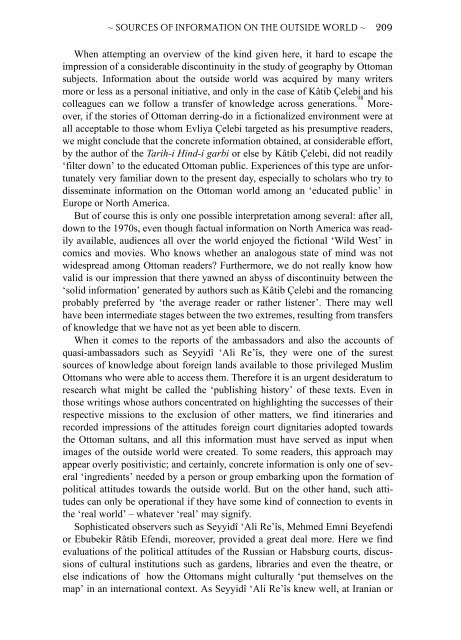The Ottoman Empire and the World Around It - Course Information
The Ottoman Empire and the World Around It - Course Information
The Ottoman Empire and the World Around It - Course Information
You also want an ePaper? Increase the reach of your titles
YUMPU automatically turns print PDFs into web optimized ePapers that Google loves.
~ SOURCES OF INFORMATION ON THE OUTSIDE WORLD ~ 209<br />
When attempting an overview of <strong>the</strong> kind given here, it hard to escape <strong>the</strong><br />
impression of a considerable discontinuity in <strong>the</strong> study of geography by <strong>Ottoman</strong><br />
subjects. <strong>Information</strong> about <strong>the</strong> outside world was acquired by many writers<br />
more or less as a personal initiative, <strong>and</strong> only in <strong>the</strong> case of Kâtib Çelebi <strong>and</strong> his<br />
colleagues can we follow a transfer of knowledge across generations. 98<br />
Moreover,<br />
if <strong>the</strong> stories of <strong>Ottoman</strong> derring-do in a fictionalized environment were at<br />
all acceptable to those whom Evliya Çelebi targeted as his presumptive readers,<br />
we might conclude that <strong>the</strong> concrete information obtained, at considerable effort,<br />
by <strong>the</strong> author of <strong>the</strong> Tarih-i Hind-i garbi or else by Kâtib Çelebi, did not readily<br />
‘filter down’ to <strong>the</strong> educated <strong>Ottoman</strong> public. Experiences of this type are unfortunately<br />
very familiar down to <strong>the</strong> present day, especially to scholars who try to<br />
disseminate information on <strong>the</strong> <strong>Ottoman</strong> world among an ‘educated public’ in<br />
Europe or North America.<br />
But of course this is only one possible interpretation among several: after all,<br />
down to <strong>the</strong> 1970s, even though factual information on North America was readily<br />
available, audiences all over <strong>the</strong> world enjoyed <strong>the</strong> fictional ‘Wild West’ in<br />
comics <strong>and</strong> movies. Who knows whe<strong>the</strong>r an analogous state of mind was not<br />
widespread among <strong>Ottoman</strong> readers? Fur<strong>the</strong>rmore, we do not really know how<br />
valid is our impression that <strong>the</strong>re yawned an abyss of discontinuity between <strong>the</strong><br />
‘solid information’ generated by authors such as Kâtib Çelebi <strong>and</strong> <strong>the</strong> romancing<br />
probably preferred by ‘<strong>the</strong> average reader or ra<strong>the</strong>r listener’. <strong>The</strong>re may well<br />
have been intermediate stages between <strong>the</strong> two extremes, resulting from transfers<br />
of knowledge that we have not as yet been able to discern.<br />
When it comes to <strong>the</strong> reports of <strong>the</strong> ambassadors <strong>and</strong> also <strong>the</strong> accounts of<br />
quasi-ambassadors such as Seyyidî ‘Ali Re’îs, <strong>the</strong>y were one of <strong>the</strong> surest<br />
sources of knowledge about foreign l<strong>and</strong>s available to those privileged Muslim<br />
<strong>Ottoman</strong>s who were able to access <strong>the</strong>m. <strong>The</strong>refore it is an urgent desideratum to<br />
research what might be called <strong>the</strong> ‘publishing history’ of <strong>the</strong>se texts. Even in<br />
those writings whose authors concentrated on highlighting <strong>the</strong> successes of <strong>the</strong>ir<br />
respective missions to <strong>the</strong> exclusion of o<strong>the</strong>r matters, we find itineraries <strong>and</strong><br />
recorded impressions of <strong>the</strong> attitudes foreign court dignitaries adopted towards<br />
<strong>the</strong> <strong>Ottoman</strong> sultans, <strong>and</strong> all this information must have served as input when<br />
images of <strong>the</strong> outside world were created. To some readers, this approach may<br />
appear overly positivistic; <strong>and</strong> certainly, concrete information is only one of several<br />
‘ingredients’ needed by a person or group embarking upon <strong>the</strong> formation of<br />
political attitudes towards <strong>the</strong> outside world. But on <strong>the</strong> o<strong>the</strong>r h<strong>and</strong>, such attitudes<br />
can only be operational if <strong>the</strong>y have some kind of connection to events in<br />
<strong>the</strong> ‘real world’ – whatever ‘real’ may signify.<br />
Sophisticated observers such as Seyyidî ‘Ali Re’îs, Mehmed Emni Beyefendi<br />
or Ebubekir Râtib Efendi, moreover, provided a great deal more. Here we find<br />
evaluations of <strong>the</strong> political attitudes of <strong>the</strong> Russian or Habsburg courts, discussions<br />
of cultural institutions such as gardens, libraries <strong>and</strong> even <strong>the</strong> <strong>the</strong>atre, or<br />
else indications of how <strong>the</strong> <strong>Ottoman</strong>s might culturally ‘put <strong>the</strong>mselves on <strong>the</strong><br />
map’ in an international context. As Seyyidî ‘Ali Re’îs knew well, at Iranian or


